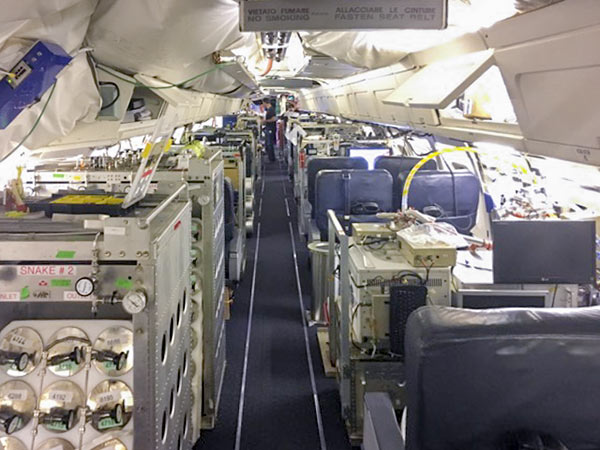COMMENT OF THE DAY: WHAT’S IN YOUR AIR  “There are three big air quality concerns for Houstonians: toxics, smog and particulates. Living in the East End puts you on the front line for toxic emissions. Toxics tend to be heavier than air and do not travel very far from where they are released. Milby Park had almost off the chart levels of Butadiene 1,3 back in mid 2000 due to problems at the Texas Petrochem plant next door. That problem was fixed and levels have come way down. But, if there is a release or a leak that is sending off toxics, the East End gets the best whiff. On days where there is little wind, the East End is also the spot most likely to get smog (NOx+SOx+sun=ozone). If there is good circulation in the atmosphere, Pearland to Sugar Land can see pretty bad smog, especially with the old coal plant in Sugar Land. But so can everywhere from Memorial Park up to the Woodlands. Houston’s smog has improved dramatically thanks to some good work by regulators and industry in identifying and going after the highly reactive stuff that really drives ozone production. But Houston is still in the top ten nationally when it comes to ozone. . . . Particulates are not as big a concern in Houston as we do not have much steel or other industries that are heavy on particulates, but we are still just over the new Federal standard of 12 parts per somethingerother. The particulates on the East End are generally higher than in other parts of town due to all the industry in the area. The air quality on the east side is definitely worse than on the west side. But ozone (smog) can visit just about anyone in the Houston area.” [Old School, commenting on Comment of the Day: The Limits of Eastward Development] Illustration: Lulu
“There are three big air quality concerns for Houstonians: toxics, smog and particulates. Living in the East End puts you on the front line for toxic emissions. Toxics tend to be heavier than air and do not travel very far from where they are released. Milby Park had almost off the chart levels of Butadiene 1,3 back in mid 2000 due to problems at the Texas Petrochem plant next door. That problem was fixed and levels have come way down. But, if there is a release or a leak that is sending off toxics, the East End gets the best whiff. On days where there is little wind, the East End is also the spot most likely to get smog (NOx+SOx+sun=ozone). If there is good circulation in the atmosphere, Pearland to Sugar Land can see pretty bad smog, especially with the old coal plant in Sugar Land. But so can everywhere from Memorial Park up to the Woodlands. Houston’s smog has improved dramatically thanks to some good work by regulators and industry in identifying and going after the highly reactive stuff that really drives ozone production. But Houston is still in the top ten nationally when it comes to ozone. . . . Particulates are not as big a concern in Houston as we do not have much steel or other industries that are heavy on particulates, but we are still just over the new Federal standard of 12 parts per somethingerother. The particulates on the East End are generally higher than in other parts of town due to all the industry in the area. The air quality on the east side is definitely worse than on the west side. But ozone (smog) can visit just about anyone in the Houston area.” [Old School, commenting on Comment of the Day: The Limits of Eastward Development] Illustration: Lulu





I agree that east of 610 puts you too close to the industrial side where NOx, SOx and H2S are going to be an issue with smell and ozone.
There are several good things happening in Houston though to regulate these emmissions.
1)Thermal imaging cameras in the bayous to catch leaks and emmissions.
2)Higher standards for Flares/Thermal Oxidizers (funny thing about these is that you need to be more worried when there is a flame and no smoke rather than flame + smoke.
3)Tighter standards for Heat Sources on SOx/NOx (Buy stock in Ammonia Suppliers)
4)New tracking data for international emmissions sources (Mexico fires and pollutants)
The main issue is going to always be cars/trucks here in Houston though. With traffic at a standstill Houston wont meet the new standards until car technology catches up.
@Mr. Clean: Yes, a lot of good progress has been made in the battle against smog. And the future growth in motor vehicle emissions threatens to negate that progress. However, the ship channel industries still have work to do and are still the bulk of the problem. Just watch the ozone monitor animations on bad air quality days. You can always see the signature of the ship channel emitters. On days with calm winds, a big red blob appears over the ship channel neighborhoods. On days when the winds come out off the Gulf, you can see the red blob get smeared out up to 290 and the Woodlands. When the winds are easterly, Sugar Land/Pearland get the red blob. That is because the ship channel emissions are still the bulk of the ozone precursors that are causing the ozone problems. Vehicle emissions, oak trees and lawn equipment (very much a reducible source if catalytic converters were mandated for lawn equipment) are definitely enablers, but the main culprit is still the ship channel.
Oak trees generate emissions?
For some reason, Bhopal comes to mind.
Heavens after reading that I’m afraid to draw a breath for I may drop dead from the poisonous air in Houston. I don’t know how I can run around Memorial Park 3 times at a good clip and not drop dead from the noxious air, my Mother was right, I must be exceptional!
Mr. Clean,
I’m not sure what you mean when you imply that the presence of smoke from a flare is better for the environment than the absence of smoke. Smoke indicates incomplete combustion (perhaps due to insufficient residence time, flame instability, or inadequate mixing of air and fuel at the flame front). If you were to have incomplete combustion of benzene, for example, you would be emitting some benzene directly to the atmosphere.
The fact the the EPA developed Methods 9 and 22 to verify that flares minimize smoke confirms that smoke is something to be avoided. Perhaps you meant to say something else?
LRS, many kinds of trees emit ozone precursors. Oaks just happen to be among the highest emitters. If memory serves, live oaks do not emit as much because of lower growth rates and less transpiration. In Houston, the effect of trees is not proportionally as great, but some small metro areas have shown that the majority of their ozone is caused by natural sources (at least on the VOC side of things).
The really nasty stuff, though, is point source and dissipates rapidly with distance. It’s one thing to talk about a neighborhood like Manchester or old Harrisburg, but the East End is a big place. If Eastwood (the neighborhood referenced by the original article) is polluted, then we may as well say that Downtown and Midtown are polluted too.
If one is that particular about breathing in particulates, why even live in a city? Most cities do not have clean air, especially car-centric cities like Houston. What the west side of Houston doesn’t get from the eastern chemical plants, it gets from the overwhelming traffic loads that choke that side of town.
@Shannon: children with asthma fill emergency rooms on high ozone days. It is a real and definite health issue for them as well as the elderly and very small children with developing lungs. You may feel fine, but that does not mean that we can ignore others who are seriously at risk. (I will skip the research showing that living in areas with bad air quality generally can reduce lifespan by a few years)
here’s a nice map for anyone concerned over air quality.
.
http://houstoncleanairnetwork.com/
.
on most days the east end has as good of air quality as the heights. you want to stay healthy and live in the loop, go for university place, but unless that is your goal, you are going to suck on the same exhaust fumes west of downtown as I do east of downtown.
@Old School – Yes ship channel is a big issue. Im working on a project un-related to this but have been talking with security folks who have installed Thermal imaging cameras out there over the past few years to catch ships leaking/over-emmitting (i guess thats the right term). Hopefully it gets better.
@eiioi – Working with a “Smokeless” ground flare rep recently in the NGL industry i was told that although smokeless was ideal, there is a higher destruction rate when these smoke. I am interested in your comment though as I consider myself somewhate of a novice in this matter.
@LRS:
http://www.nrs.fs.fed.us/units/urban/local-resources/downloads/vocrates.pdf
@Ed: Non-ozone precursor tailpipe emissions from vehicles are significant if you live within 1000 ft from the highway. But beyond 1000 ft, there isn’t any significant pollution from tailpipe emissions. Thus, it is simply not true that the traffic on the West side of Houston makes up for the ship channel industry.